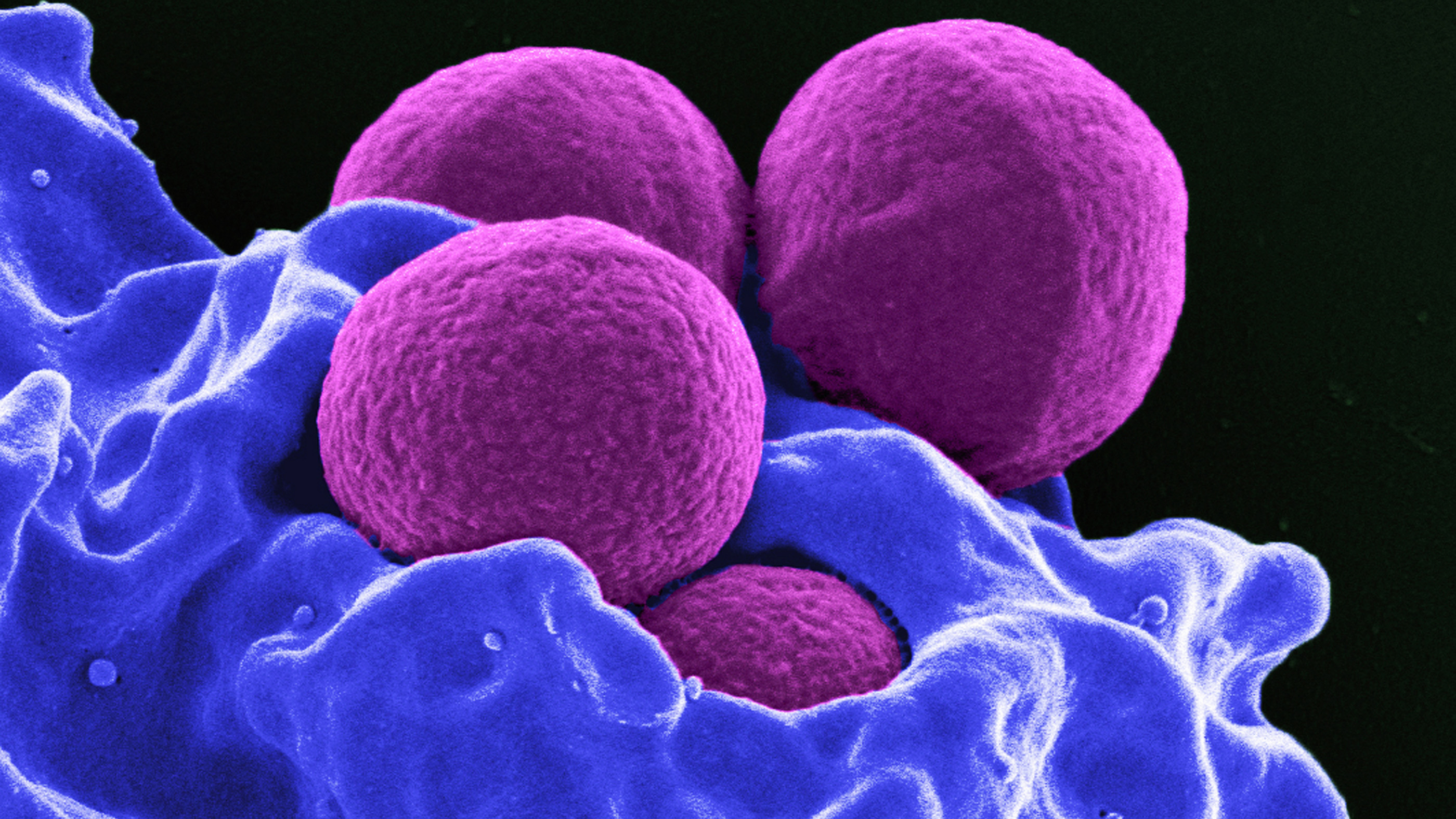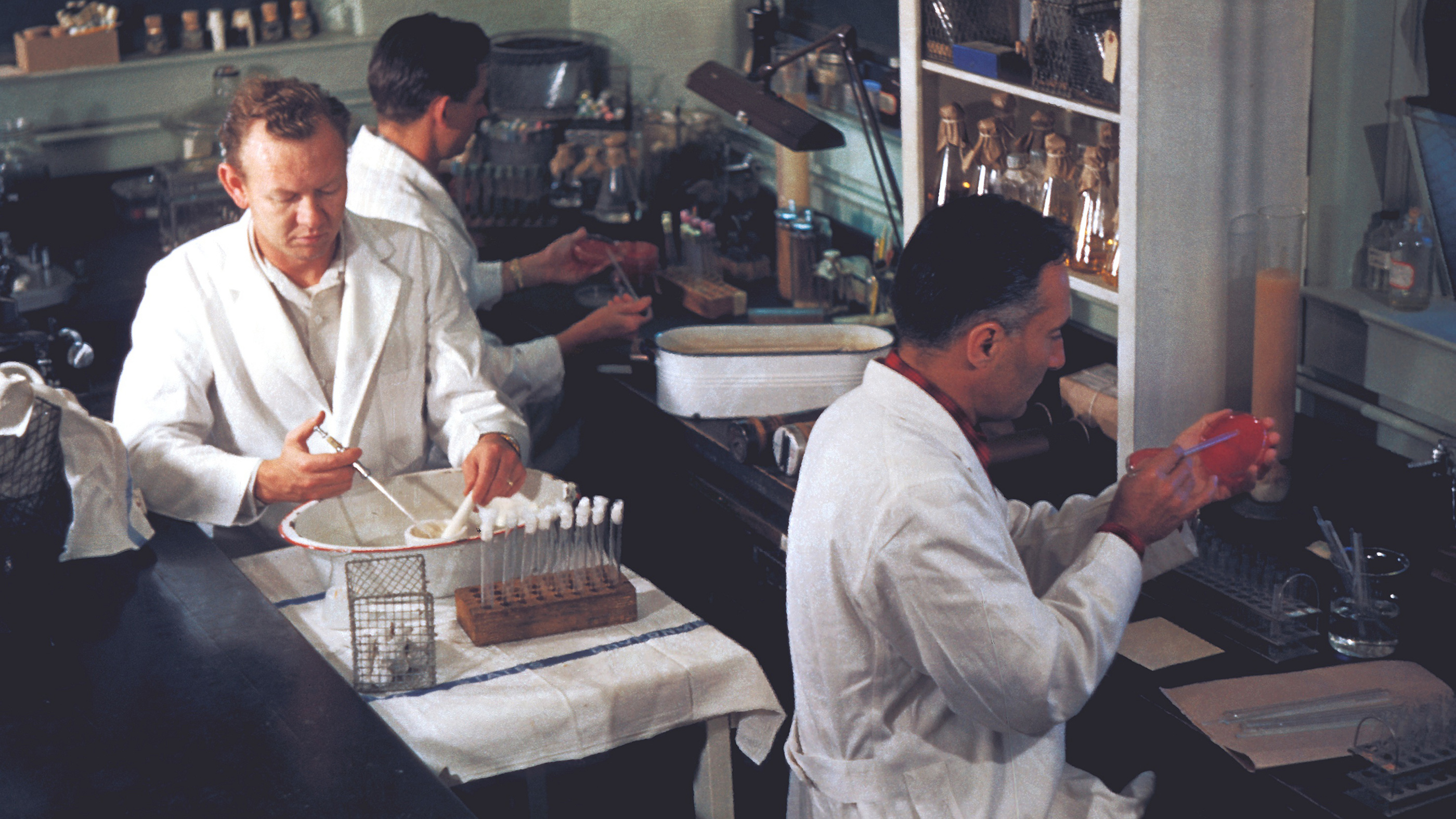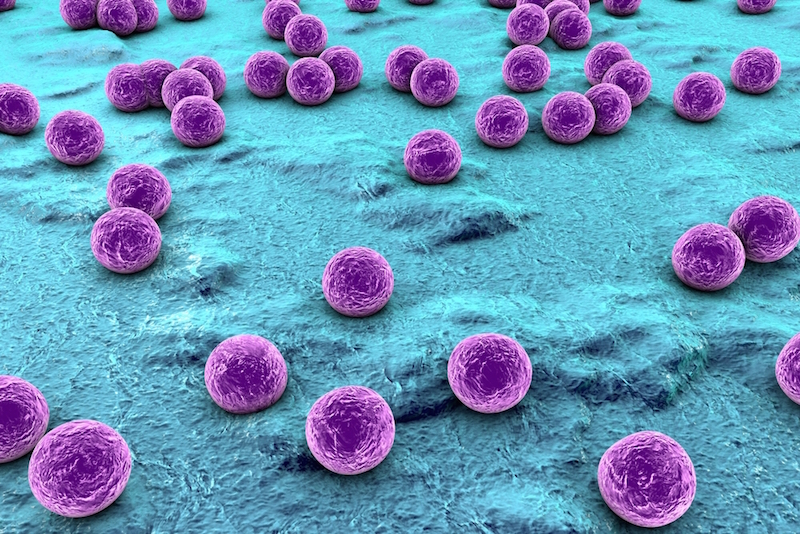What Happens If You Incubate Bacteria Too Long
What are bacteria?

(opens in new tab)
Bacteria are single-celled organisms that are pretty much everywhere: in the ground, in the bounding main, on your hands and in your gut. While some are harmful, well-nigh are not — and some are fifty-fifty beneficial to man health. In many cases, humans live in symbiosis with bacteria, maintaining a mutually benign human relationship without even knowing it.
So permit'southward demystify this diverse group of single-celled organisms. Here is an overview of what bacteria are, what they do and which ones to sentinel out for.
What are leaner?

(opens in new tab)
Bacteria are single-celled organisms with a unique internal structure. Humans and other multicellular organisms are eukaryotes, which ways our cells take distinct nuclei bound with a membrane. Bacteria are prokaryotes, meaning they don't have organized nuclei or any other membrane-bound organelles.
Bacterial DNA floats freely inside bacterial cells in a twisted, thread-like mass called the nucleoid. Some also accept separate, circular pieces of DNA called plasmids. Co-ordinate to the Microbiology Club, plasmids oft contain genes that give bacteria a survival edge, such as genes conveying antibiotic resistance.
Bacteria shouldn't exist confused with the other major group of prokaryotes called archaea. Archaea are also single-celled organisms, merely the ii groups differ in the kinds of molecules they use to build their prison cell walls and in the metabolic processes they use.
Structure of bacteria

(opens in new tab)
Bacteria come up in 5 bones shapes: spherical, cylindrical, comma-shaped, corkscrew and spiral. The scientific names for these shapes are cocci (round), bacilli (cylindrical), vibrios (comma-shaped), spirochaetes (corkscrew) and spirilla (spiral). The shapes and configurations of bacteria are oft reflected in their names. For example, the milk-curdling Lactobacillus acidophilus are bacilli, and pneumonia-causing Streptococcus pneumoniae are a chain of cocci.
Bacterial cells are generally surrounded by an outer prison cell wall and an inner cell membrane. Certain bacteria, like the mycoplasmas, do not have a cell wall at all. Some bacteria may even have a tertiary, outermost protective layer, called the capsule. Whip-like extensions often comprehend the surfaces of bacteria — long ones, chosen flagella, or brusk ones, called pili — and help leaner motility around and attach to a host.
Leaner can exist classified by the limerick of their cell walls using a test called the Gram stain, according to the Science Education Resource Heart at Carleton College. The examination stains Gram-positive leaner, or leaner that do not have an outer membrane. Gram-negative bacteria, which do have an outer membrane, don't option up the stain. For example, S. pneumoniae is a Gram-positive bacterium, but Escherichia coli, which can cause food poisoning, and Vibrio cholerae, which causes cholera, are Gram-negative bacteria.
Delving below the cell wall and membrane, bacteria contain cytoplasm, a solution of mostly water and salts. Within the cytoplasm float the nucleoid, plasmids and tiny poly peptide factories called ribosomes, which are the sites where the cell'due south genetic instructions are translated into the prison cell'southward products. Some antibiotics, like tetracycline, target bacterial ribosomes to prevent them from synthesizing proteins, thus dooming the cell.
The cytoplasm of some bacteria may also have little pockets, called inclusions, where nutrients are stored for lean times. Photosynthetic bacteria, which generate energy from sunlight, may accept structures called chromatophores spread throughout their cytoplasm. These chromatophores agree pigments used in photosynthesis.
How do bacteria eat and reproduce?
Every bit some of the oldest life-forms on Earth, leaner have evolved a dizzying number of ways to survive. Some bacteria are photosynthetic, while others are chief decomposers, breaking downwardly rotting and decomposable organic material into nutrients. Some enter symbiotic, or mutually benign, relationships with a host (more on this subsequently).
Most bacteria multiply by a process called binary fission, according to the Cornell University College of Agriculture and Life Sciences. In this procedure, a single bacterial prison cell, called the "parent," makes a re-create of its Dna and grows larger by doubling its cellular content. The cell then splits apart, pushing the duplicated textile out and creating 2 identical "daughter" cells.
Some types of bacteria, such as cyanobacteria and firmicutes, reproduce via budding. In this case, the daughter cell grows as an offshoot of the parent. Information technology starts off as a small nub, grows until information technology is the same size as its parent and then splits off.
After binary fission or budding, the Dna plant in parents and offspring is exactly the same. Therefore, bacterial cells introduce variation into their genetic material by integrating additional DNA, often from their surroundings, into their genome. This is known equally horizontal gene transfer, according to the San Diego State University College of Sciences. The resulting genetic variation ensures that bacteria tin adjust and survive every bit their environment changes, Live Science previously reported.
In that location are three means horizontal cistron transfer occurs: transformation, transduction and conjugation.

(opens in new tab)
Transformation is the nigh common process of horizontal gene transfer and occurs when a bacterium absorbs curt Deoxyribonucleic acid fragments from the environment through its cell membrane. (The DNA fragments are released into the environment by other bacteria.) To undergo transformation, a bacterium must be in a state known equally competence. This ordinarily happens when nutrients are scarce or when the density of a bacterial colony is high. In these circumstances, information technology might exist evolutionarily advantageous to try out some new DNA.
Transduction occurs when a virus picks upward Dna from one bacterium and infects another bacterium, inserting the new gene sequence. Conjunction happens when bacteria make direct contact. A donor cell sprouts a tube-similar appendage, called a pilus, and directly passes DNA to a recipient cell. This happens with E. coli , in which some individual cells carry a special type of plasmid known as the fertility factor, or F cistron, according to "Modern Genetic Analysis" (W. H. Freeman and Company, 1999). These F gene cells can donate DNA to cells that are F factor-negative. The third type of transfer, chosen conjugation, aids in the spread of antibiotic-resistance genes.
How are bacteria benign to wellness?
Many bacteria are beneficial to humans. Nosotros harness their power to curdle milk into yogurt and ferment cabbage into kimchi. Some species even do their piece of work within us. According to the Microbiology Society, at that place are about 10 times equally many bacterial cells every bit man cells inside a person's body, and many of these live in the digestive tract. These bacteria go a abiding stream of nutrients from the human being gut. In return, they help pause downward foods that homo digestive enzymes tin't. Bacteroides thetaiotaomicron, for example, helps break downwards complex carbohydrates. L. acidophilus breaks down sugars in milk and creates byproducts such as lactic acid and hydrogen peroxide, according to the Mount Sinai wellness library; these byproducts make the intestines less hospitable for harmful bacteria.
Bacteria on the skin can also produce byproducts that proceed harmful bacteria away, according to a 2018 paper in the journal Nature Reviews Microbiology (opens in new tab). The benign bacterium Corynebacterium accolens, for case, inhibits the growth of the pneumonia-causing Due south. pneumoniae.
Some skin bacteria can be both helpful and harmful. Staphylococcus epidermidis is a spherical bacterium that commonly colonizes the skin but can cause infection if information technology gets inside the human body. Even so, S. epidermidis as well produces proteins that inhibit the growth of its more virulent relative, Staphylococcus aureus. Due south. aureus also causes infections when it gets past the barrier of the skin, but they're typically much more serious than S. epidermidis infections.
How are bacteria harmful to wellness?

(opens in new tab)
Some leaner, like South. aureus, live in relative peace with humans nearly of the time; about thirty% of people carry South. aureus in their noses, co-ordinate to the Centers for Disease Command and Prevention (CDC). But when these bacteria find their way into the body, peculiarly in people who are immunocompromised, they can crusade fatal infections. Staph infections can cause sepsis (total-trunk inflammation in response to infection), pneumonia, endocarditis (inflammation of the eye and eye valves) and osteomyelitis (inflammation of the bone), according to the CDC.
Other bacteria are almost always harmful to humans. Cholera, a diarrheal disease that kills almost 95,000 people worldwide each year, is caused by Five. cholerae. The bacterium Yersinia pestis, spread by fleas that bite rodents, was responsible for the Black Death. And Bacillus anthracis can class almost indestructible anthrax spores that lurk in soil and can cause deadly disease if inhaled or consumed.
Some of the most common problematic bacteria infect people through spoiled food. Salmonella bacteria cause an affliction called salmonellosis, marked by diarrhea, stomach cramping and fever. Though well-nigh people recover afterward four to vii days, salmonellosis can be serious, and even fatal, in both young children and older people, according to the CDC.
Due east. coli, some other bacterium responsible for food poisoning, often spreads through contaminated food and water. While many strains live harmlessly in human intestines, others cause diarrheal illness. Like salmonellosis, E. coli diarrhea is typically deeply unpleasant but cursory, though five% to 10% of people develop a kidney complexity called hemolytic uremic syndrome, which can be life-threatening, co-ordinate to the CDC.
Some other mutual bacterium that tin can be harmful to people is Helicobacter pylori. Nigh one-half of people carry these bacteria in their stomachs, co-ordinate to the Mayo Clinic. Most people never evidence whatsoever ill effects of this infection, merely in some cases, the leaner cause peptic ulcers, or painful sores in the lining of the stomach. It'south non entirely clear how the bacteria spread, only risk factors include crowded livi
What is bacterial vaginosis?
Bacterial vaginosis is a status in which anaerobic leaner (bacteria that practise non use oxygen in their metabolism) overtake Lactobacillus, a type of benign leaner, in the vagina. Symptoms include vaginal itching, gray or green discharge, a fishy aroma and pain during urination, according to the Mayo Clinic.
Bacterial vaginosis is mutual: A national report conducted betwixt 2001 and 2004 found that 29% of women randomly tested for the bacteria that crusade the status had it, corresponding to about 21 million women in the U.S. afflicted at any given fourth dimension. (Simply about 15% of the women who tested positive had symptoms.)
It's not clear what causes bacterial vaginosis, according to the Mayo Clinic. Some people are likely susceptible because their vaginal environment is not equally comfortable for the Lactobacillus leaner that make up a healthy vaginal microflora. Douching or having sexual practice with a new partner or with multiple sexual partners can be a hazard factor, mayhap because these activities disrupt the usual bacterial communities in the vagina. Bacteria commonly associated with bacterial vaginosis include Gardnerella vaginalis, Prevotella species, Mobiluncus species and Atopobium vaginae, co-ordinate to the CDC.
If untreated, bacterial vaginosis is a risk factor for preterm birth and can make a person more than susceptible to contracting sexually transmitted infections. Bacterial vaginosis can exist treated with antibiotics.
Antibody resistance

Antibiotics are typically used to treat bacterial infections. Withal, in contempo years, improper and unnecessary use of antibiotics has promoted the spread of several strains of antibiotic-resistant bacteria.
In cases of antibody resistance, the infectious bacteria are no longer susceptible to previously effective antibiotics. According to the CDC, at to the lowest degree ii one thousand thousand people in the U.South. are infected with antibiotic-resistant leaner every year, leading to t23,000 deaths annually.
"Pretty much whatever infection you can recall of now has been identified every bit being associated with some level of resistance," said Dr. Christopher Crnich, an infectious-disease physician and hospital epidemiologist at the University of Wisconsin Hospitals and William S. Middleton Memorial Veterans Hospital. "There's very few infections that we now treat where infections caused by resistant bacteria is not a clinical business organisation."
MRSA, for example, is i of the more than notorious antibiotic-resistant bacterial strains; it resists methicillin and other antibiotics used to treat Staphylococcus infections, which are caused primarily through skin contact. MRSA infections occur in wellness care settings such as hospitals and nursing homes, where it can pb to pneumonia or bloodstream infections. MRSA also spreads in communities, peculiarly in situations where there is a lot of exposed peel, other physical contact and the use of shared equipment — for example, among athletes, in tattoo parlors, and in day intendance facilities and schools, co-ordinate to the CDC. Customs-caused MRSA nearly ofttimes causes serious pare infections.
An important facet of combating antibiotic resistance is to be careful about their use. "It's so important for us to utilise antibiotics intelligently," Crnich told Live Scientific discipline. "You simply want to use an antibody when you take a clear-cut bacterial infection."
Additional resources:
- Read more than near the life history and ecology of bacteria from the University of California, Berkeley.
- Scout: Bacteria: Energy Producers of the Hereafter? From the National Science Foundation.
- Learn how bakers and their bread are a microbial friction match, from NPR.
This article was updated on Oct. xiv, 2021, by Live Science Contributor Stephanie Pappas.
Source: https://www.livescience.com/51641-bacteria.html
Posted by: brownthabould.blogspot.com

0 Response to "What Happens If You Incubate Bacteria Too Long"
Post a Comment